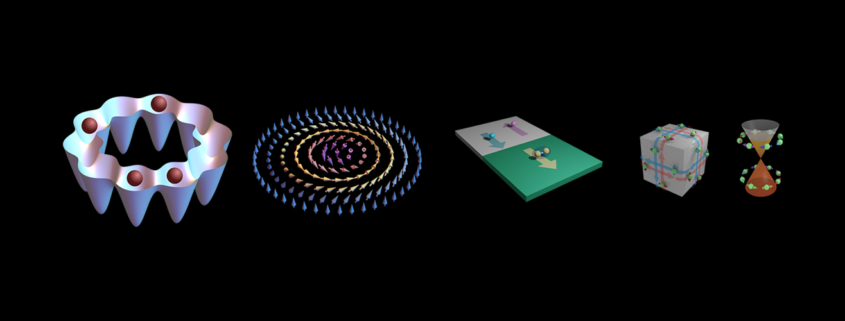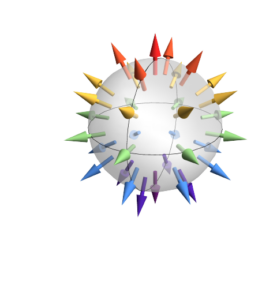
Theoretical research on quantum phenomena in materials.

In our laboratory, we aim to elucidate the frontier of condensed matter physics by theoretically studying systems comprising numerous electrons and atoms. Electrons exhibit diverse properties such as metals, semiconductors, and insulators due to their Fermi statistics. Additionally, phenomena such as magnetism and superconductivity occur due to spontaneous symmetry breaking. On the other hand, atoms with quantized lattice vibrations, spin waves, and integer spins follow Bose statistics, and Bose-Einstein condensation occurs as density increases. Once condensation occurs, a large number of particles are described by the same wave function, making the quantum nature of the material observable on a macroscopic scale. In addition to traditional condensed matter physics research, we have been exploring the field of topological quantum physics in recent years.
Topology is a mathematical method for classifying shapes under continuous deformation. In this framework, certain integers called topological invariants are defined. By classifying Hamiltonians and wave functions using this method, materials with nontrivial topology are organized. For example, materials called topological insulators have metallic properties only on their surface while being insulating internally, and these have been recently discovered, leading to explosive growth in this field. Surrounding materials include anomalous Hall systems, topological crystal insulators, and Weyl semimetals, which are topologically nontrivial. While these systems discuss topology in momentum space, it is also possible to discuss topology in real space, revealing structures such as quantum vortices and magnetic skyrmions. Changes in quantum states in momentum space or real space create effective gauge fields in systems, allowing control of particle and spin motion, attracting attention as new materials for spintronics.
On the other hand, there is also interest in superconductors with topologically nontrivial edge states (topological superconductors). Singular quasi-particles called Majorana fermions, which cannot distinguish between generation and annihilation, appear as edge states. The nonlocal correlation effects of Majorana fermions are said to be useful for future quantum computing. Topological quantum physics is being studied in various systems such as topological insulators, superconductors, superfluid helium-3, and cooled atomic gases, predicting the existence of particles with not only fermions and bosons but also new statistics. Furthermore, attempts have been made in recent years to control the topology of systems through driving external fields or to create new quantum states through interaction with the environment.
We aim to form an internationally excellent research base that pioneers the frontier of quantum physics by broadly studying topological quantum phenomena (from solid-state electron systems to atomic systems such as cooled gases). We welcome ambitious students who actively participate in cutting-edge research by collaborating with staff and graduate students. Collaboration with leading research laboratories both domestically and internationally is highly active, not only within our laboratory but also beyond.
details of the main research areas
- Magnetic Skyrmions
- Theory of Ultracold Atomic Systems
- Superconducting Junctions
- Topological Materials
